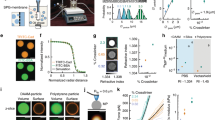Abstract
We have developed a method that combines dynamic force microscopy with the simultaneous molecular recognition of an antigen by an antibody, during imaging. A magnetically oscillated atomic force microscopy tip carrying a tethered antibody was scanned over a surface to which lysozyme was bound. By oscillating the probe at an amplitude of only a few nanometers, the antibody was kept in close proximity to the surface, allowing fast and efficient antigen recognition and gentle interaction between tip and sample. Antigenic sites were evident from reduction of the oscillation amplitude, as a result of antibody–antigen recognition during the lateral scan. Lysozyme molecules bound to the surface were recognized by the antibody on the scanning tip with a few nanometers lateral resolution. In principle, any ligand can be tethered to the tip; thus, this technique could potentially be used for nanometer-scale epitope mapping of biomolecules and localizing receptor sites during biological processes.
This is a preview of subscription content, access via your institution
Access options
Subscribe to this journal
Receive 12 print issues and online access
$209.00 per year
only $17.42 per issue
Buy this article
- Purchase on Springer Link
- Instant access to full article PDF
Prices may be subject to local taxes which are calculated during checkout



Similar content being viewed by others
References
Binnig, G., Quate, C.F. & Gerber, Ch. Atomic force microscope. Phys. Rev. Lett . 56, 930–933 ( 1986).
Drake, B. et al. Imaging crystals, polymers, and processes in water with the atomic force microscope. Science 243, 1586–1589 (1989).
Shao, Z. & Yang, J. Progress in high resolution atomic force microscopy. Q. Rev. Biophys. 28, 195 –251 (1995).
Müller, D.J., Schabert, F.A., Büldt, G. & Engel. A. Imaging purple membranes in aqueous solutions at sub-nanometer resolution by atomic force microscopy. Biophys. J. 68, 1681–1686 (1995).
Lee, G.U., Kidwell, D.A. & Colton, R.J. Sensing discrete streptavidin-biotin interactions with atomic force microscopy. Langmuir 10, 354–357 (1994).
Florin, E.L., Moy, V.T. & Gaub, H.E. Adhesion forces between individual ligand receptor pairs. Science 264, 415–417 (1994).
Boland, T. & Ratner, B.D. Direct measurement of hydrogen bonding in DNA nucleotide bases by atomic force microscopy. Proc. Natl. Acad. Sci. USA 92, 5297–5301 (1995).
Hinterdorfer, P., Baumgartner, W., Gruber, H.J., Schilcher, K. & Schindler, H. Detection and localization of individual antibody-antigen recognition events by atomic force microscopy. Proc. Natl. Acad. Sci. USA 93, 3477– 3481 (1996).
Dammer, U. et al. Specific antigen/antibody interactions measured by force microscopy. Biophys. J. 70, 2437–2441 (1996).
Allen, S. et al. Spatial mapping of specific molecular recognition sites by atomic force microscopy. Biochemistry 36, 7457– 7463 (1997).
Ros, R. et al. Antigen binding forces of individually addressed single-chain Fv antibody molecules. Proc. Natl. Acad. Sci. USA 95, 7402–7405 (1998).
Wong, S.S., Joselevich, E., Woolley, A.T., Cheung, C.L. & Lieber, C.M. Covalently functionalyzed nanotubes as nanometre-sized probes in chemistry and biology. Nature 394, 52–55 (1998).
Hinterdorfer, P., Schilcher, K., Baumgartner, W., Gruber, H.J. & Schindler, H.A. Mechanistic study of the dissociation of individual antibody–antigen pairs by atomic force microscopy. Nanobiology 4, 39–50 ( 1998).
Willemsen, O.H.E. et al. Simultaneous height and adhesion imaging of antibody–antigen interactions by atomic force microscopy. Biophys. J. 57, 2220–2228 (1998).
Fritz, J., Katopidis, A.G., Kolbinger, F. & Anselmetti, D. Force-mediated kinetics of single P-selectin/ligand complexes observed by atomic force microscopy. Proc. Natl. Acad. Sci. USA 95, 12283–12288 (1998).
Frisbie, C.D., Rosznyai, F., Noy, A., Wrighton, M.S. & Lieber, C.M. Functional group imaging by chemical force microscopy. Science 256, 2071–2074 (1994).
Evans, E. & Ritchie, K. Dynamic strength of molecular adhesion bonds. Biophys. J. 72, 1541– 1555 (1997).
Ludwig, M., Dettmann, W. & Gaub, H.E. Atomic force microscopy imaging contrast based on molecular recognition. Biophys. J. 72, 445 –448 (1997).
Han, W., Lindsay, S.M. & Jing, T. A magnetically driven oscillating probe microscope for operation in liquid. Appl. Phys. Lett. 69, 1–3 (1996).
Han, W., Lindsay, S.M., Dlakic, M. & Harrington, R.E. Kinked DNA. Nature 386, 563 ( 1997).
Han, W., Dlakic, M., Zhu, Y.J., Lindsay, S.M. & Harrington, R.E. Strained DNA is kinked by low concentrations of Zn2+. Proc. Natl. Acad. Sci. USA 94, 10565–10570 (1997).
Radmacher, M., Fritz, M., Hansma, H.G. & Hansma, P.K. Direct observation of enzyme activity with the atomic force microscope. Science 265, 1577–1579 (1994).
Phillips, D.C. The hen egg white lysozyme molecule. Proc. Natl. Acad. Sci. USA 57, 484–495 ( 1967).
Haselgrübler, Th., Amerstorfer, A., Schindler, H. & Gruber, H.J. Synthesis and applications of a new poly(ethylene glycol) derivative for the crosslinking of amines with thiols. Bioconjugate Chem. 6, 242–248 (1995).
Acknowledgements
We are grateful to Drs. Hermann J. Gruber and Werner Baumgartner for enlightening discussions. This work was supported by the Austrian Science Foundation projects P12801/2-MED (A.R., D.B., H.S., and P.H.), the Austrian Ministry of Science project GZ200.026/2-Pr/4/98 (A.R., D.B., H.S., and P.H.), the EC-BIOTECHNOLOGY program project ERBBIO4CT960592 (A.R., D.B., H.S., and P.H.), the National Institutes of Health (S.J.S.-G.), and the National Science Foundation project BIR 9513233 (S.M.L.).
Author information
Authors and Affiliations
Corresponding author
Rights and permissions
About this article
Cite this article
Raab, A., Han, W., Badt, D. et al. Antibody recognition imaging by force microscopy. Nat Biotechnol 17, 901–905 (1999). https://doi.org/10.1038/12898
Received:
Accepted:
Issue Date:
DOI: https://doi.org/10.1038/12898
This article is cited by
-
Scanning probe microscopy
Nature Reviews Methods Primers (2021)
-
Imaging modes of atomic force microscopy for application in molecular and cell biology
Nature Nanotechnology (2017)
-
Combining confocal and atomic force microscopy to quantify single-virus binding to mammalian cell surfaces
Nature Protocols (2017)
-
Cytosolic targeting factor AKR2A captures chloroplast outer membrane-localized client proteins at the ribosome during translation
Nature Communications (2015)



